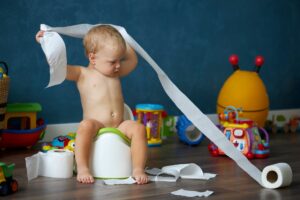The Essentials
The hitting phase usually lasts a few months but can vary depending on the child and the circumstances. Learn more…
Toddlers often hit due to frustration, lack of communication skills, or seeking attention. Learn more…
Consistently enforcing boundaries and using time-outs or other age-appropriate consequences can help. Learn more…
In your child’s early years, one of the most challenging questions can be how to stop you toddler from hitting. It can be frustrating and even embarrassing, especially if the hitting happens in public.
This comprehensive guide will give you the tools and strategies you need to deal with this behaviour effectively and encourage healthy emotional expression. We will explore the reasons behind hitting, teach you how to help your child express emotions in healthier ways, and discuss the importance of setting boundaries and reinforcing positive behaviours.
Table of contents
Understanding the Hitting Behaviour

If you want to learn how to stop your toddler from hitting, it is essential to underatand, why children show this behaviour in the first place. In this chapter we will look at the reasons why young children resort to hitting.
Trusting the Process
Stay patient and consistent in applying the strategies discussed in this guide, and remember that your toddler’s hitting phase is a normal part of their development that they will eventually outgrow
We will explore the developmental stage they are in, their limited communication skills and how they express their emotions. This understanding will form the basis of the strategies discussed in the following chapters.
- Developmental stage: Toddlers are at a stage where they are exploring their environment and developing their motor skills. They may hit out of curiosity or as a means of experimentation without fully understanding the consequences of their actions.
- Communication limitations: Young children have a limited vocabulary and often struggle to express their feelings or needs. Hitting may be a way for them to communicate frustration, anger or a need for attention when they don’t have the words.
- Emotional regulation: At this age, children are still learning to regulate their emotions. They may lash out as a knee-jerk reaction to feeling overwhelmed or upset without knowing other ways to cope.
Teaching Healthy Emotional Expression
An important topic that relates to the question how to stop toddlers from hitting is emotional expression. Here we will discuss ways to teach your toddler how to express their emotions in healthier ways.
A Space to Calm Down
Create a “calm down” corner in your home, where your toddler can go to cool off and practice self-soothing techniques when they’re feeling overwhelmed or upset.
These are age-appropriate activities and exercises to help them recognise their feelings and offer alternatives to hitting when they are frustrated or angry:
- Identify emotions: Use simple language to help your toddler identify his or her emotions. Practice naming emotions such as “angry”, “sad” or “happy” when you see them experiencing them.
- Emotion regulation techniques: Teach your toddler deep breathing exercises, counting to ten, or using a stress ball to calm down when they’re upset. Encourage them to use these techniques instead of hitting.
- Role-playing scenarios: Engage your toddler in role-playing exercises to practice resolving conflicts without hitting. This will help them develop empathy and learn to express their feelings in a more constructive way.
How to Stop Toddlers from Hitting by Setting Clear Boundaries

In this chapter we will emphasise the importance of setting clear boundaries and consistently enforcing age-appropriate consequences for hitting. We will provide examples of effective strategies to discourage your toddler from hitting and explain how these techniques can encourage better behaviour in the long term.
No Physical Violence Ever!!
It is never appropriate to use physical punishment as a response to hitting. This is not only damaging to your child and your relationship with them but also ineffective. Phisical punishment can send mixed messages to your child and may lead to an escalation of aggressive behaviors.
Here are some practical steps you can take if you are struggling with how to stop a toddler from hitting:
- Set boundaries: Make it clear to your toddler that hitting is not acceptable. Use simple language and be consistent in your message.
- Time out: If your toddler hits, enforce a time-out to give him a chance to calm down and think about his actions. Make sure the time out is age appropriate (e.g. one minute per year of age).
- Natural consequences: Help your child understand the natural consequences of hitting, such as hurting other people’s feelings or losing time with friends. This will encourage them to think before they act.
Reinforcing Positive Behaviors
In raising little children, it is not only about how to stop a toddler from hitting, but also about teaching them to engage in positive behaviours. Learn about the importance of reinforcing positive behaviour and how to do this effectively.
Did You Know?
Research has shown that teaching your child empathy and helping them understand the feelings of others can significantly reduce aggressive behaviors like hitting
This is how you can use praise and rewards to encourage your toddler to communicate and express emotions in a more constructive way:
- Praise: Offer specific praise when your child expresses his or her feelings in a healthy way or resolves a conflict without hitting. For example, “I like the way you used your words to tell me you were angry instead of hitting me”.
- Rewards: Create a reward system to motivate your child to avoid hitting and use healthier coping strategies. For example, offer stickers or small treats for each day they don’t hit, and gradually increase the rewards for longer periods of good behaviour.
- Model behaviour: Be a positive role model for your child by demonstrating healthy ways to express emotions and resolve conflicts. Your child will learn from your example and be more likely to adopt these behaviours.

Guiding Your Toddler towards Healthy Emotional Expression
Throughout this guide, we have provided you with practical strategies and tools to address this challenging stage in your child’s development. By understanding the reasons for hitting, teaching healthy emotional expression, setting clear boundaries and reinforcing positive behaviours, you can lay the foundation for improved communication and emotional regulation.
While it’s important to remain patient and consistent, remember that this is a normal part of your toddler’s development and will eventually pass. With your loving guidance and support, your toddler will learn to manage their emotions and express themselves in healthier ways, paving the way for a hitting-free future.
Sources:
- https://www.washingtonpost.com/lifestyle/on-parenting/why-kids-hit–and-what-to-do-about-it/2018/12/04/53da7fd6-f25d-11e8-bc79-68604ed88993_story.html
- https://timesofindia.indiatimes.com/life-style/parenting/toddler-year-and-beyond/how-to-stop-your-toddler-from-hitting-others/photostory/94203469.cms?from=mdr
- https://www.theguardian.com/commentisfree/2021/jul/14/my-three-year-old-keeps-attacking-his-little-brother-how-can-i-stop-him













